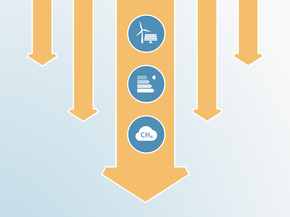Current Policy Projections
Overview
According to our most recent assessment, with currently implemented policies Brazil will reach emissions levels (excluding LULUCF) of 1.047 MtCO2e in 2025 and 1.095 MtCO2e by 2030 (respectively, 26% and 32% above 2005 levels and 90% and 99% above 1990 levels). Brazil will need to implement additional policies to meet its NDC targets.
Recent economic and political turmoil has resulted in an economic recession and non-LULUCF emissions growing at a slower pace than in the last decade and even decreasing slightly in 2015 and 2016. However, under currently implemented policies, emissions in most sectors are expected to rise at least until 2030 and the remarkable progress in forestry emissions mitigation observed over the last decade seems to have stopped with deforestation emissions reverting to an upward trend. Recent developments in energy infrastructure planning and the reversal of LULUCF policies already in place reflect a worsening of national climate policy implementation and ambition.
To contribute to a global peak in emissions followed by a steep decrease in the coming decades, as required under the Paris Agreement, Brazil will need to reverse its current trend of weakening climate policy by sustaining and strengthening policy implementation in the forestry sector, reversing present steps to expand fossil fuel energy sources, and accelerating mitigation action in other sectors.
The main policy instruments included in our current policy projections pathway are the energy efficiency national plans and the incentives for the uptake of renewables in the energy sector, including capacity auctions in the power sector and the ethanol and biodiesel mandates in the transport sector (IEA, 2016).
Brazil has enacted other sectoral plans to reduce emissions in other sectors of the economy, including the Mitigation and Adaptation to Climate Change for a Low-Carbon Emission Agriculture (ABC Plan), the Steel Industry Plan, the Low Carbon Emission Economy in the Manufacturing Industry Plan, The Sectoral Transport and Urban Mobility Plan and the Low-Carbon Emission Mining Plan. Most of those policies and instruments, however, are still not part of national development planning and are therefore not included in our current policy projections emissions pathway. This section outlines the most recent policy developments in Brazil’s two largest emissions sectors – LULUCF and energy - and the different challenges ahead in each of those sectors.
Land Use and Land Use Change sector
Inventory emissions data available shows that the land use and forestry sector had been by far the largest source of GHG emissions in Brazil since the early 1990s. This picture changed significantly after 2004, when effective anti-deforestation policies, including the National Forest Code, the Action Plan for Deforestation Prevention and Control in the Legal Amazon (PPCDAm) and the Cerrado (PPCerrado), were implemented and resulted in a reduction on LULUCF emissions of about 86% between 2005 and 2012 (Ministry of Science Technology and Innovation of Brazil, 2016a).
While this was a very positive development, the remarkable progress in forestry emissions mitigation seems to have stopped, with deforestation emissions increasing again in recent years (Observatório do Clima, 2017b). Recent data shows that total deforestation increased almost 30% in 2016 compared to 2015 and more than 50% in the Amazon region (IPAM, 2017) (Observatório do Clima, 2017a). Experts have estimated that deforestation alone has added around 130 MtCO2 to total net emissions in 2016 (Observatorio do Clima, 2016b), endangering the achievement of the national targets for the Paris Agreement, which include a target of zero illegal deforestation in the Brazilian Amazonia by 2030.
This recent increase in deforestation represents a reversal of the trend over the last decade and local authorities have declared they lack the resources to control illegal deforestation in the entire national territory (Messias, 2017). The enforcing capacity of national authorities has deteriorated due to sharp spending cuts under the recent fiscal austerity principle implemented as a response to the spiralling fiscal deficit. In 2017, the Government cut the Environment Ministry budget by more than 50% (Climate Home, 2017a), with continued cuts in 2018. The National Institute for Space Research (INPE), responsible among others for the satellite monitoring of deforestation in the Amazon, suffered nearly 70% reduction in its budget in the past 7 years (Estado de São Paulo, 2017)
Not only has the enforcing capacity of authorities been reduced, but the Government has also started to reverse LULUCF policies already in place. Last July, President Temer signed legislation, previously approved by Congress, to regularise more illegal land-grabbing practices and sent a bill to Congress that that would remove protection from 349,000 hectares (862,000 acres) of Jamanxim National Forest, in the Amazon state of Pará (Climate Home, 2017b).
This, combined with the economic recession that pushes low income populations to undertake deforestation as an economic activity, could result in growing deforestation emissions in the future, unless continuous efforts to maintain low levels of deforestation are made, and additional policies are implemented to achieve even lower levels (Observatorio do Clima, 2016a).
One of the most negative consequences of the lack of progress in deforestation policies is the endangerment of the multilateral Amazon Fund that provides funds to fight deforestation in the Amazon. In June, Norway reduced its contribution to the fund by $60 million and funds could drop even further if current deforestation trends continue (World Resources Institute, 2017). This could result in a downward spiral that could put the NDC target of zero illegal deforestation in the Brazilian Amazon by 2030 out of reach.
In July 2017, the government presented an estimate of official deforestation data in the Amazon in 2017 showing that deforestation fell by 16% between August 2016 and July 2017 (PRODES, 2017). While those are good news, the are several reasons not to get too excited about the fall in the deforestation rate: this estimate only covers the Amazon, but there is uncertainty about other important regions like Cerrado and Mato Grosso; prolonged drought resulted in an increase in fires in 2017(Observatorio do clima, 2017); and finally, more recent data (Jan 2018) shows that deforestation for soybean plantation grew 27% with respect to the previous year, mostly in the Mato Grosso region(Observatorio do clima, 2018).
Given the key role of the LULUCF sector in Brazil’s NDC and the huge importance of its forests for environmental services, biodiversity, and carbon sequestration, the Brazilian government needs urgently to strengthen mitigation action in the sector instead of weakening it.
Energy supply sector
Brazil’s energy mix has been characterised by a high share of renewables, especially large hydroelectric generation in the electricity sector. However, mainly due to increasing transportation activity and fossil-fuel electricity generation, the energy sector is Brazil’s fastest growing emissions source (Observatório do Clima, 2017b). Taking into account that Brazil’s energy market is expanding and will continue to do so at least until 2030 (IEA, 2015), the renewable energy NDC targets of a 45% share in the primary energy mix and a 23% share of renewables (other than hydropower) in the power supply mix by 2030 would, if met, contribute to an improvement in Brazil’s carbon intensity.
However, plans to decarbonise the Brazilian power sector appear to be contradicted by recent policy developments. In fact, the share of fossil fuels in the Brazilian energy matrix is increasing while the share of renewable energy sources in the energy supply has been declining - from around 50% in the 1990s to only 39% in 2014 (Observatorio do Clima, 2016a). This trend has been driven by an increase in energy demand and challenges the hydroelectric sector has faced in times of scarce water resources (US Energy Information Administration, 2016). Special concern is raised by the current government energy infrastructure planning, which seems to continue favouring fossil fuels, including coal and gas, as opposed to what is required under the Paris Agreement (Climate Action Tracker, 2016).
To meet the increasing energy demand, the government is planning to diversify the energy mix and lower dependency on hydroelectric power by increasing investments in fossil fuels. The Ten-year Plan for Energy Expansion has planned an increase in the share of investments in fossil energy sources to 70.6% of total energy investments in 2024 (Ministério de Minas e Energia, 2015). Between 2013 and 2016, non-renewable sources had an increase of 4.3% in the primary energy production, with same proportion decreasing of renewables, with largest increase coming from oil (Ministerio de Minas e Energia, 2017)
In the second half of 2016 the Senate approved a provision on a bill on electricity sector privatisation that could result in subsidies for the modernisation of the coal fleet and the addition of new coal plants from 2023 onwards (Senado Federal, 2016). The government also sent negative signals to the wind and solar industry by cancelling its only reserve energy auction for wind and solar in December 2016, arguing for an expected power oversupply in the country (Reuters, 2016). Finally, in December 2017 the National Congress approved a further tax exemption to oil and gas exploration, valid until December 2040 which will add up to over a trillion reais (USD 309 billion) lost from the public purse (Câmara dos Deputados, 2018)
These recent developments may ultimately limit the options for long-term deep decarbonisation of the Brazilian economy as a consequence of unnecessarily locking in a high level of carbon-intensive energy infrastructure. Under current policy projections, the indicative NDC target of a 45% share of renewables in the total energy mix by 2030 will be underachieved and the share of renewables will stagnate at 43%. Unless additional policies are put in place, emissions in the energy sector will continue to rise in the coming decades (IEA, 2015), leaving the huge national potential for renewable power generation untapped.
Further analysis
Latest publications
Stay informed
Subscribe to our newsletter




